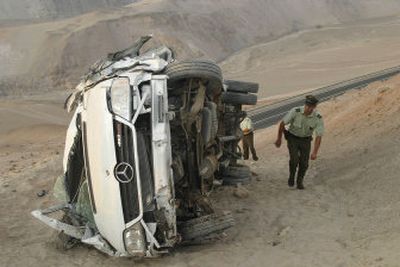Peru’s dangerous curves

LIMA, Peru – Brandon Russell remembers the sound of screeching tires and passengers’ screams as their double-decker bus hurtled off a 60-foot cliff in Peru’s high southern Andes.
“We went through the guard rail. Everybody up top was screaming,” the 14-year-old said in a telephone interview from his home in Vancouver, Wash.
“I thought it was like one of those rolly hills, where you go down and it just feels like your tummy tickles,” he said. “I had no idea what was going on until we impacted.”
Surgeons removed the teenager’s spleen and repaired his perforated stomach and punctured lung after the August 2004 crash on a narrow, winding highway between Cuzco and Lake Titicaca.
His mother is still undergoing operations to repair more than a dozen bones, fractured and shattered when seats broke free and flew through the cabin.
Her other son, Alex, 17, helped pull both of them from the wreckage.
The makeshift vehicle – one of hundreds of buses in Peru illegally grafted onto the chassis of flatbed trucks – went into a skid after the driver missed the turn onto a bridge and crashed into a dry riverbed. He was killed along with seven others.
A legal and political battle is now raging over efforts to get the deadly passenger haulers off Peru’s roads.
South America’s reputation for dangerous bus travel and lax enforcement was tragically confirmed March 22 when 12 elderly American tourists died in a bus crash on a curvy mountain road in northern Chile. Authorities suspect the driver fell asleep at the wheel of the bus, which was unregistered and not allowed to carry passengers.
The wreck occurred near the border with Bolivia, notorious for its “Highway of Death,” a 40-mile road touted as the “world’s deadliest” that drops some 12,000 feet from a snowcapped mountain into a steaming jungle. Hundreds of bus passengers and others have died along the route, which also attracts thrill-seeking mountain bikers.
The bus passenger death toll keeps rising throughout the Andes. In Ecuador, a passenger bus tumbled 1,000 feet off a jungle mountain road March 24, killing 17 passengers and injuring 16 others. Colombia reported 513 deaths and 2,782 injuries in 2004 from accidents involving long-distance buses.
But Peru is arguably the most notorious among Andean nations for the stunning regularity of accidents involving passenger buses that plunge off winding roads, or crash head-on while passing other vehicles on blind mountain curves.
Overall, 557 people were killed and 2,581 others injured in “inter-provincial” bus accidents between July 2004 and June 2005, according to Peru’s Center for Investigation of Overland Transport.
Experts say a major cause of the high number of accidents is the recklessness of the drivers.
Alex Russell recalled telling a Canadian friend sitting next to him “about how fast these buses go and how it should actually be a 12-hour trip but it’s only an eight-hour trip.
“The first 20 minutes of the trip, we’re flying down a dirt road going about 75 or 80 miles per hour,” he said. “I opened the window to show my friend Mark, and we were both wide-eyed, going like, ‘Wow!’ “
Alex Russell said he was briefly knocked unconscious but was otherwise not hurt in the accident. His friend suffered a deep gash on his eyebrow.
Peru’s estimated 400 “bus-trucks,” which account for about 10 percent of the country’s 3,770 buses, appear new but are structurally unsound and account for a third of the fatalities, said Lino de la Barrera, vice president of the transport center.
The bus trucks have inadequate brake systems and are four times more likely to cause deaths than Peru’s normal buses, which tend to be 10 to 15 years old and run-down, he said.
Peru outlawed bus-trucks in 2002, but companies used a loophole to keep putting them on the roads.
The country’s Transportation Ministry in February announced a crackdown on the vehicles, and about a dozen of the illegal buses were decommissioned. Peru’s constitutional Tribunal then struck down a challenge from the bus-truck operators, saying public safety takes precedence over any lost business.
But bus-truck owners, a powerful lobby, have persuaded a congressional commission to debate proposals that would allow bus-trucks to be refurbished and continue circulating for up to 15 more years.
Meanwhile, the bus-trucks keep rolling, and crashing.
Twenty-six people died on Feb. 26 in the southern Peruvian highlands of Arequipa when one of the prohibited vehicles skidded off an unpaved road and plunged 670 feet into a gorge. That bus company was fined about $5,300 for operating an unauthorized vehicle, local media reported.
A dozen more people were killed two days later – among them, two American tourists riding a bus operated by one of Peru’s most reputable transport companies, Ormeno.
It was struck head-on by a bus-truck trying to pass another vehicle, police said.